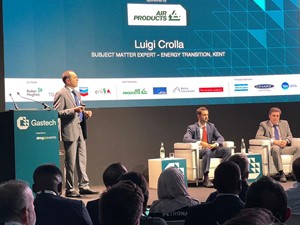News
Repurposing existing infrastructure: Capital expenditures involved with onshore vs. offshore H2 production
On day 3 of Gastech 2022 in Milan, Italy, Luigi Crolla, Subject Matter Expert – Energy Transition for Kent plc, delivered a presentation evaluating the ideal locations for producing H2 by harnessing wind power.
Crolla begins his presentation by explaining the uses of H2, such as producing chemicals, plastics, iron and steel, and its use in power generation. However, the issue is that H2 is primarily produced from fossil fuels, which generate CO2 emissions.
The solution to this problem is producing green H2. A renewable power source (e.g., solar or wind) is required and used in water electrolysis to produce green H2, enabling carbon-neutral H2.
Crolla went on to describe the challenges involved with green H2 production. He acknowledged the issues of global trade, policies and costs. However, the primary topic touched upon was whether onshore or offshore facilities were the better option for green H2 production.
To evaluate the best economic circumstances for H2 production, Kent assessed centralized production onshore, centralized production offshore and distributed production onshore.
“The study assumes that the technology that will be used is expected to be available in the next 5 yr,” Crolla said. “We went for the megawatt (MW) scale, which we see as achievable in the next 5 yr.”
According to Crolla, the overall capacity of a wind farm and electrolyzer system is based on 100 MW—10 wind turbines with a 10 MW capacity with a windfarm distance of 30 km. They used these parameters to determine the most cost-effective strategy to produce green H2.
- Centralized production onshore. A substation transfers the power to the onshore location from distributed turbines. In this scenario, an electrical grid connection for the electrolyzer is feasible.
- Centralized production offshore. The power is transferred to a centralized offshore location from distributed turbines; then, the H2 is transported onshore. In this scenario, an electrical grid connection is not possible.
- Distributed production offshore. The power is utilized at the turbine, and the H2 is produced offshore. In this scenario, an electrical grid connection is not possible.
Their research concludes that the levelized cost of H2 is more favorable in offshore production, largely due to the high costs of the high voltage cables required for the transportation of electricity to produce green H2.
In a conversation with H2Tech, Crolla said, “A wind farm, for example, is offshore, but when the electrodes are transported onshore, about 5%–10% of power is lost, depending on the distance of the wind farm. We use the electrolyzer offshore and gain the extra 5%–10% that otherwise may have been lost. This is also beneficial because existing infrastructure, such as pipelines, can be reused to reduce investment costs.”
According to Crolla, several companies are already using this method and several projects in the UK, such as ERM Dolphyn and Salamander.
However, there are costs for offshore H2 production that must be assessed as well. Crolla mentions that managing several electrical units offshore will be challenging, and offshore maintenance costs are typically more expensive than onshore. These are the next steps that must be analyzed.H2T


